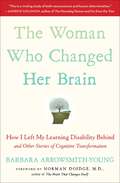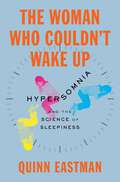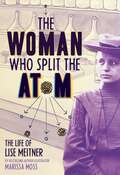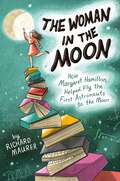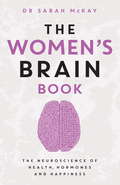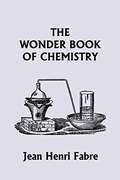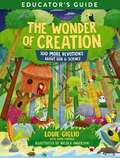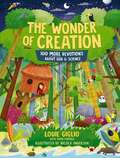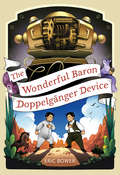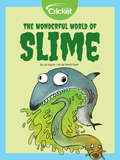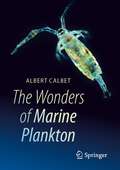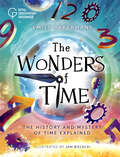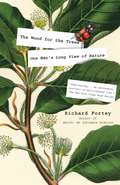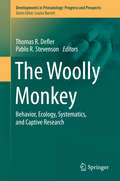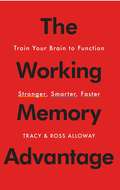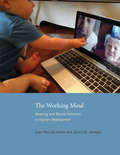- Table View
- List View
The Woman Who Changed Her Brain: And Other Inspiring Stories of Pioneering Brain Transformation
by Barbara Arrowsmith-YoungBarbara Arrowsmith-Young was born with severe learning disabilities that caused teachers to label her slow, stubborn—or worse. As a child, she read and wrote everything backward, struggled to process concepts in language, continually got lost, and was physically uncoordinated. She could make no sense of an analogue clock. But by relying on her formidable memory and iron will, she made her way to graduate school, where she chanced upon research that inspired her to invent cognitive exercises to “fix” her own brain. The Woman Who Changed Her Brain interweaves her personal tale with riveting case histories from her more than thirty years of working with both children and adults. Recent discoveries in neuroscience have conclusively demonstrated that, by engaging in certain mental tasks or activities, we actually change the structure of our brains—from the cells themselves to the connections between cells. The capability of nerve cells to change is known as neuroplasticity, and Arrowsmith-Young has been putting it into practice for decades. With great inventiveness, after combining two lines of research, Barbara developed unusual cognitive calisthenics that radically increased the functioning of her weakened brain areas to normal and, in some areas, even above-normal levels. She drew on her intellectual strengths to determine what types of drills were required to target the specific nature of her learning problems, and she managed to conquer her cognitive deficits. Starting in the late 1970s, she has continued to expand and refine these exercises, which have benefited thousands of individuals. Barbara founded Arrowsmith School in Toronto in 1980 and then the Arrowsmith Program to train teachers and to implement this highly effective methodology in schools all over North America. Her work is revealed as one of the first examples of neuroplasticity’s extensive and practical application. The idea that self-improvement can happen in the brain has now caught fire. The Woman Who Changed Her Brain powerfully and poignantly illustrates how the lives of children and adults struggling with learning disorders can be dramatically transformed. This remarkable book by a brilliant pathbreaker deepens our understanding of how the brain works and of the brain’s profound impact on how we participate in the world. Our brains shape us, but this book offers clear and hopeful evidence of the corollary: we can shape our brains.
The Woman Who Couldn't Wake Up: Hypersomnia and the Science of Sleepiness
by Quinn EastmanSleep was taking over Anna’s life. Despite multiple alarm clocks and powerful stimulants, the young Atlanta lawyer could sleep for thirty or even fifty hours at a stretch. She stopped working and began losing weight because she couldn’t stay awake long enough to eat. Anna’s doctors didn't know how to help her until they tried an oddball drug, connected with a hunch that something produced by her body was putting her to sleep.The Woman Who Couldn’t Wake Up tells Anna’s story—and the broader story of her diagnosis, idiopathic hypersomnia (IH), a shadowy sibling of narcolepsy that has emerged as a focus of sleep research and patient advocacy. Quinn Eastman explores the science around sleepiness, recounting how researchers have been searching for more than a century for the substances that tip the brain into slumber. He argues that investigation of IH could unlock new understandings of how sleep is regulated and controlled. Eastman foregrounds the experiences of people with IH, relating how publicity around Anna’s successful treatment helped others form a community. He shows how a group of patients who felt neglected or dismissed united to steer research toward their little-known disorder.Sharing emerging science and powerful stories, this book testifies to the significance of underrecognized diseases and sheds new light on how our brains function, day and night. It is essential reading for anyone interested in sleep and sleep disorders, including those affected by or seeking to treat them.
The Woman Who Split the Atom: The Life of Lise Meitner
by Marissa MossAs a female Jewish physicist in Berlin during the early 20th century, Lise Meitner had to fight for an education, a job, and equal treatment in her field, like having her name listed on her own research papers. <P><P>Meitner made groundbreaking strides in the study of radiation, but when Hitler came to power in Germany, she suddenly had to face not only sexism, but also life-threatening anti-Semitism as well. Nevertheless, she persevered and one day made a discovery that rocked the world: the splitting of the atom. While her male lab partner was awarded a Nobel Prize for the achievement, the committee refused to give her any credit. <P><P>Suddenly, the race to build the atomic bomb was on—although Meitner was horrified to be associated with such a weapon. “A physicist who never lost her humanity,” Meitner wanted only to figure out how the world works, and advocated for pacifism while others called for war. <P><P>The book includes an afterword, author's note, timeline, select terms of physics, glossary of scientists mentioned, endnotes, select bibliography, index, and Marissa Moss’s celebrated drawings throughout. The Woman Who Split the Atom is a fascinating look at Meitner’s fierce passion, integrity, and her lifelong struggle to have her contributions to physics recognized.
The Woman in the Moon: How Margaret Hamilton Helped Fly the First Astronauts to the Moon
by Richard MaurerA stunning and intimate biography of Margaret Hamilton, the computer engineer who helped Apollo 11 and mankind get from the Earth to the moon.First-hand accounts, exclusive interviews with the legendary Margaret Hamilton, and detailed science populate the pages of this remarkable biography. In 1969, mankind successfully left our atmosphere and landed on the moon. It took countless hours of calculations, training, wonder, and sacrifice from all of the men and women who worked hard to make that landing. One of those people was Margaret Hamilton. A young computer engineer, Hamilton was hired to develop the completely new software used in the groundbreaking Apollo Space Program. Soon she became the lead engineer, one of the few women in the almost entirely male-dominated profession. But it wasn't always easy. In The Woman in the Moon, science-writer and journalist Richard Maurer (Destination Moon, 2019) dives deep into the backstory of this extraordinary woman. With first-hand interviews and access to primary sources, this striking biography perfectly captures the exciting atmosphere of the Space Race and the inspiring figure of Margaret Hamilton.
The Women's Brain Book: The neuroscience of health, hormones and happiness
by Dr Sarah McKayFor women, understanding how the brain works during the key stages of life - in utero, childhood, puberty and adolescence, pregnancy and motherhood, menopause and old age - is essential to their health. Dr Sarah McKay is a neuroscientist who knows everything worth knowing about women's brains, and shares it in this fascinating, essential book.This is not a book about the differences between male and female brains, nor a book using neuroscience to explain gender-specific behaviours, the 'battle of the sexes' or 'Mars-Venus' stereotypes. This is a book about what happens inside the brains and bodies of women as they move through the phases of life, and the unique - and often misunderstood - effects of female biology and hormones. Dr McKay give insights into brain development during infancy, childhood and the teenage years (including the onset of puberty) and also takes a look at mental health as well as the ageing brain. The book weaves together findings from the research lab, case studies and interviews with neuroscientists and other researchers working in the disciplines of neuroendocrinology, brain development, brain health and ageing.This comprehensive guide explores the brain during significant life stages, including:In uteroChildhoodPubertyThe Menstrual CycleThe Teenage BrainDepression and AnxietyPregnancy and MotherhoodMenopauseThe Ageing Brain
The Women's Brain Book: The neuroscience of health, hormones and happiness
by Dr Sarah McKayFor women, understanding how the brain works during the key stages of life - in utero, childhood, puberty and adolescence, pregnancy and motherhood, menopause and old age - is essential to their health. Dr Sarah McKay is a neuroscientist who knows everything worth knowing about women's brains, and shares it in this fascinating, essential book.This is not a book about the differences between male and female brains, nor a book using neuroscience to explain gender-specific behaviours, the 'battle of the sexes' or 'Mars-Venus' stereotypes. This is a book about what happens inside the brains and bodies of women as they move through the phases of life, and the unique - and often misunderstood - effects of female biology and hormones. Dr McKay give insights into brain development during infancy, childhood and the teenage years (including the onset of puberty) and also takes a look at mental health as well as the ageing brain. The book weaves together findings from the research lab, case studies and interviews with neuroscientists and other researchers working in the disciplines of neuroendocrinology, brain development, brain health and ageing.This comprehensive guide explores the brain during significant life stages, including:In uteroChildhoodPubertyThe Menstrual CycleThe Teenage BrainDepression and AnxietyPregnancy and MotherhoodMenopauseThe Ageing Brain
The Wonder Book Of Chemistry
by Jean-Henri FabreStarting with a mixture of iron filings and sulphur, Uncle Paul awakens in his young nephews an eagerness to learn more about the properties of the elements. Through a series of carefully-devised experiments and conversations about the experiments, he leads the boys to an understanding of some of the basic principles of chemistry. Excellent as a follow-on to "The Story Book of Science" and "The Secret of Everyday Things" by the same author. Suitable for ages 11 and up.
The Wonder of Birds: What They Tell Us About Ourselves, the World, and a Better Future
by Jim RobbinsA fascinating investigation into the miraculous world of birds and the powerful—and surprising—ways they enrich our lives and sustain the planet. Our relationship to birds is different from our relationship to any other wild creatures. They are found virtually everywhere and we love to watch them, listen to them, keep them as pets, wear their feathers, even converse with them. Birds, Jim Robbins posits, are our most vital connection to nature. They compel us to look to the skies, both literally and metaphorically; draw us out into nature to seek their beauty; and let us experience vicariously what it is like to be weightless. Birds have helped us in so many of our human endeavors: learning to fly, providing clothing and food, and helping us better understand the human brain and body. And they even have much to teach us about being human in the natural world. This book illuminates qualities unique to birds that demonstrate just how invaluable they are to humankind—both ecologically and spiritually. The wings of turkey buzzards influenced the Wright brothers’ flight design; the chickadee’s song is considered by scientists to be the most sophisticated language in the animal world and a “window into the evolution of our own language and our society”; and the quietly powerful presence of eagles in the disadvantaged neighborhood of Anacostia, in Washington, D.C., proved to be an effective method for rehabilitating the troubled young people placed in charge of their care. Exploring both cutting-edge scientific research and our oldest cultural beliefs, Robbins moves these astonishing creatures from the background of our lives to the foreground, from the quotidian to the miraculous, showing us that we must fight to save imperiled bird populations and the places they live, for the sake of both the planet and humankind.
The Wonder of Creation (Indescribable Kids)
by Louie GiglioThe Wonder of Creation Educator's Guide is a companion to The Wonder of Creation: 100 More Devotions About God and Science by Louie Giglio. This guide can be utilized in the classroom, in a home school setting, or by parents seeking additional resources. Ideal for grades 3rd-5th.
The Wonder of Creation: 100 More Devotions About God and Science (Indescribable Kids)
by Louie GiglioIn this captivating follow-up to the bestselling kids' devotionals Indescribable and How Great Is Our God, discover more mind-blowing, faith-building scientific facts and biblical truths about the wonder of God's creation from author, speaker, and founder of the Passion movement Louie Giglio.Well-known for his powerful and highly visual messages about science and the Bible, Louie Giglio has a passion for inspiring kids to notice, enjoy, and marvel at God's creation. In The Wonder of Creation, children will find new delight in God's creativity with 100 devotions that explore:animals—from honeyguide birds to flying snakes to white rhinosspace—from black holes to volcanic moons to gamma-ray burstspeople—from optical illusions to brain freezes to our immune systems Earth—from rainbow rivers to blue lava to flowing glaciers and much, much more!With engaging illustrations and striking photography, this fun and informative book is ideal for children ages 6–10. Each of the 100 devotions features a scientific fact or an easy activity for exploring faith, a short Bible verse, and a closing prayer.With a beautifully bright and colorful cover and a ribbon bookmark, The Wonder of Creationis ideal for science-loving kids, Bible-loving kids, and any child ready to go deeper in faithcontinues a well-loved devotional series that has impacted over a million children, parents, and teachersincludes informative content call-outs inviting kids to "Explore the Wonder"makes a great addition to a homeschool STEM curriculum or a bedtime reading routineAs kids explore this awe-inspiring devotional, they'll be amazed at the many wonders God has made!Check out these other books in the bestselling Indescribable Kids series:IndescribableIndescribable for Little OnesHow Great Is Our God
The Wonderful Baron Doppelganger Device (The Bizarre Baron Inventions)
by Eric BowerWhen someone gets ahold of the Barons’ Wonderful Doppelgänger Device, which allows them to transform into anyone, they use it to land Rose in jail by posing as her to cause a small explosion during the Pitchfork Fair. The dastardly villain then ambushes W.B. and abducts him onto a train bound for the other side of the country. With W.B. out of the way, the imposter replaces him until W.B. returns unexpectedly and exposes the plot. Unfortunately, the deadly duplicate is great at impersonation. To save his skin, W.B. must prove himself by W.B.ing harder than he’s ever W.B.ed before.
The Wonderful Flight to the Mushroom Planet (Mushroom Planet #1)
by Eleanor CameronChuck and David pay a visit to the Mushroom Planet.
The Wonderful World of Slime
by Liz HuyckDid you know that humans are actually pretty slimy? Slide into the wonderful world of slippery, sticky slime! Learn about the important functions of slime, and how it is necessary for most living organisms. Slime helps with many important functions including eating, breathing, moving, and self-defense. Learn how many animals depend on slime—the number may surprise you!
The Wonders of Creation: Learning Stewardship from Narnia and Middle-Earth (Hansen Lectureship Series)
by Kristen PageWhen an author of fiction employs the imagination and sets characters in a new location, they are in a sense creating a world. Might such fictional worlds give us a deeper appreciation for our own?Many readers have found themselves, like the Pevensie children, transported by C. S. Lewis into Narnia, and they have traveled from Lantern Waste to Cair Paravel and the edge of the sea. Thanks to J. R. R. Tolkien, readers have also journeyed with Bilbo, Frodo, and their companions across Middle-earth from the Shire to the Lonely Mountain, the forest of Mirkwood, the mines of Moria, and the very fires of Mount Doom. But as often as we enter these fictional worlds as readers, we eventually return to our world refreshed with sharpened insight.The Wonders of CreationBased on the annual lecture series hosted at Wheaton College's Marion E. Wade Center, volumes in the Hansen Lectureship Series reflect on the imaginative work and lasting influence of seven British authors: Owen Barfield, G. K. Chesterton, C. S. Lewis, George MacDonald, Dorothy L. Sayers, J. R. R. Tolkien, and Charles Williams.
The Wonders of Marine Plankton
by Albert CalbetMarine plankton, despite their tiny size, are crucial for the functioning of marine food webs. It is not just about one organism eating another; when this happens, it helps release the nutrients accumulated within living matter, making them available again for microalgae. Plankton are present in freshwater and in all the seas and oceans on the planet. Moreover, they are responsible for supporting life on Earth and has provided us (on geological timescales) with a significant portion of the oxygen we breathe. In just a small spoonful of seawater, we can find around fifty million viruses, five million bacteria, hundreds of thousands of small unicellular flagellates, thousands of microscopic algae, five heterotrophic ciliates or dinoflagellates, and, with some luck, a small crustacean like copepods. This book aims to bridge the gap between scientific research and the general public, offering a captivating exploration of the fascinating world of marine plankton. Through engaging narratives and visually compelling illustrations, readers will gain insights into the importance of plankton in marine ecosystems, their diverse forms, and the crucial role they play in maintaining our planet's health.
The Wonders of Time
by Emily AkkermansIt's time for a mind-blowing look at the history and mystery of time with the masters of timekeeping - travelling across the globe and even to the far reaches of space!The Wonders of Time is written by the expert Curator of Time at the home of timekeeping, Royal Observatory Greenwich. The book uncovers the history and mysteries of time: its beginnings, the methods of measuring it, how we experience it, different philosophies of time and the potential of time travel. Readers explore the timeline of timekeeping, looking at the evolution of our understanding from the Big Bang to today.Just some of the astonishing contents of The Wonders of Time: - The beginning of time in the Universe, on Earth and measuring time on other planets in the solar system- The shape of time (is it a circle? a line? a spiral?) and our natural body clocks- The invention of timekeeping straight through to quartz and atomic clocks- Coordinating timezones across the world- Record-breakers in time: lifespans in humans and animals- Considering our human urge to capture moments in time (take a photo! bury a time capsule!)- Take a tour of seven amazing clocks from around the worldThis is the third book in a series published by Wayland in association with Royal Observatory Greenwich exploring the wonders of science, illustrated by the super-creative Jan Bielecki. Other books in the series include: Wonders of the Night Sky and The Future of the Universe by Professor Raman Prinja.
The Wondrous Universe
by Gerhard BörnerThe world as it is viewed from modern physics and cosmology has many strange and unexpected features. Often these are in stark contrast with our everyday experience or our preconceptions, such as the concept of space and time as finite and changeable. Nevertheless it is this strange world which is the fundamental basis of our existence. Therefore modern science also has a few things to say about the age-old questions: Who are we? - Where do we come from? - Where are we going? The author, an experienced scientist and teacher, presents the knowledge that we have about our world for non-experts. He takes us on a journey through cosmology and the quantum world of elementary particles. And he sketches the impact of the insights gained into philosophical assumptions and religious beliefs in these disciplines. In the end he asks the speculative question whether there is something beyond the limits of the natural sciences.
The Wood for the Trees: One Man's Long View of Nature
by Richard ForteyFrom the author of Earth: An Intimate History, an exuberant "biography" of four acres of woodland, evoking a cosmos of living and inanimate things and imagining its millennia of existence A few years ago, award-winning scientist Richard Fortey purchased four acres of woodland in the Chiltern Hills of Oxfordshire, England. The Wood for the Trees is the joyful, lyrical portrait of what he found there.With one chapter for each month, we move through the seasons: tree felling in January, moth hunting in June, finding golden mushrooms in September. Fortey, along with the occasional expert friend, investigates the forest top to bottom, discovering a new species and explaining the myriad connections that tie us to nature and nature to itself. His textured, evocative prose and gentle humor illuminate the epic story of a small forest. But he doesn't stop at mere observation. The Wood for the Trees uses the forest as a springboard back through time, full of rich and unexpected tales of the people, plants, and animals that once called the land home. With Fortey's help, we come to see a universe in miniature.From the Hardcover edition.
The Woolly Monkey
by Thomas R. Defler Pablo R. StevensonWoolly monkeys are large, attractive and widespread primates found throughout many parts of the Amazon basin. It is only in the last twenty-five years or so that long-term studies of woollies in their forest habitat have been successful; they have not generally been successfully kept in captivity. But now, especially because of their size, these creatures are pressed on all sides by bush meat hunters and forest fragmentation. Their future is becoming critically precarious and the editors feel that it is time to showcase these animals with a full book. The editors draw together a number of recent woolly monkey studies from three Amazonian countries, including five taxa of woolly monkeys, four of which have recently been reclassified without using new biological criteria as species rather than subspecies (Groves, 2001, 2005; Rylands & Mittermeier, 2009). This volume provides a diversity of studies by well-known researchers and advanced students on a wide range of subjects using newly generated data, including a criticism of the recent taxonomic changes. The varied information contained within The Woolly Monkey: Behavior, Ecology, Systematics and Captive Research will help readers understand these handsome animals and will, we hope, energize them to contribute to their conservation.
The Work of Nature: How The Diversity Of Life Sustains Us
by Paul R. Ehrlich Harold A. Mooney Abigail Rorer Yvonne Baskin Jane Lubchenco"We do not question that flesh and bone and leaf litter will decay to dust, that seeds will sprout season after season and find renewed nourishment in the soil, that rivers can flow endlessly without running dry, that we can breathe a lifetime without depleting the air of oxygen.... What humans have not fully appreciated until recently is that these services are the work of nature, performed by the rich diversity of microbes, plants, and animals on the earth." --from The Work of NatureThe lavish array of organisms known as "biodiversity" is an intricately linked web that makes the earth a uniquely habitable planet. Yet pressures from human activities are destroying biodiversity at an unprecedented rate. How many species can be lost before the ecological systems that nurture life begin to break down?In The Work of Nature, noted science writer Yvonne Baskin examines the threats posed to humans by the loss of biodiversity. She summarizes and explains key findings from the ecological sciences, highlighting examples from around the world where shifts in species have affected the provision of clean air, pure water, fertile soils, lush landscapes, and stable natural communities.As Baskin makes clear, biodiversity is much more than number of species -- it includes the complexity, richness, and abundance of nature at all levels, from the genes carried by local populations to the layout of communities and ecosystems across the landscape. Ecologists are increasingly aware that mankind's wanton destruction of living organisms -- the planet's work force -- threatens to erode our basic life support services. With uncommon grace and eloquence, Baskin demonstrates how and why that is so.Distilling and bringing to life the work of the world's leading ecologists, The Work of Nature is the first book of its kind to clearly explain the practical consequences of declining biodiversity on ecosystem health and function.
The Work of the Zoo Doctors at the San Diego Zoo (Zoo World)
by Georgeanne IrvineDescribes the work of the veterinarians at the San Diego Zoo as they treat sick and injured animals and work to save species through conservation and breeding programs. Other books by this author are available in this library.
The Working Memory Advantage
by Ross Alloway Tracy AllowayAs revolutionary as Emotional Intelligence, this is the first book to explore the tremendous importance of working memory--a stronger predictor of success in life than IQ--and provide a wealth of simple exercises for enhancing this crucial skill.Working memory--the ability to hold and process incoming information actively in one's mind--lies at the heart of most important life functions. Learning, decision-making, prioritization, time management, and multitasking all rely on working memory. Research has also shown that it is a key determinant of happiness; people with strong working memory are more optimistic and more hopeful about the future. Tracy Alloway and her husband Ross, leading experts on this subject, present not only their own findings, but all of the most important recent breakthroughs in the field, including studies that show that many children with learning problems and ADD have weak working memories. The good news is that working memory can be improved, and the authors offer a host of simple exercises that can help everyone make significant and lasting gains in brain function. Equal parts descriptive and prescriptive, The Working Memory Advantage offers unprecedented insight into one of the most important psychological breakthroughs of the past ten years--and a vital new approach to maximizing mental performance.
The Working Memory Advantage: Train Your Brain to Function Stronger, Smarter, Faster
by Ross Alloway Tracy AllowayA bigger asset than IQ: The first book to introduce the newly discovered--and vitally important--mental skill known as working memory, showing how it is crucial to our success in work and life and how to strengthen it.Working memory--your ability to work with information--influences nearly everything you do. What if you could find a way to better handle a crazy schedule or expertly manage risks? What if you could gain an advantage in climbing the career ladder or in school or sports? What if there were a way to improve your outlook on life, to face each day with more optimism and confidence? Tracy and Ross Alloway, leading experts in the field, show how working memory is the key to all that and more. They present important recent findings, including research on how Facebook can help with working memory, how working memory can improve your kids' grades, how it changes as you age, and how working memory is linked with ADHD, autism, dyslexia, and Alzheimer's. The Alloways describe their Jungle Memory program, which Ross created to help children improve their working memories, and is rapidly being embraced by the education community. Most importantly, they share the best news: you can improve your memory! Their book provides three tests to find out how good your working memory is--and more than fifty targeted exercises designed to help readers both process and memorize the information to maximize effectiveness. The Working Memory Advantage offers unprecedented insight into one of the most important cognitive breakthroughs in recent years--a vital new approach to making your brain stronger, smarter, and faster.
The Working Mind: Meaning and Mental Attention in Human Development
by Juan Pascual-Leone Janice M. JohnsonA general organismic-causal theory that explicates working memory and executive function developmentally, clarifying the nature of human intelligence.In The Working Mind, Juan Pascual-Leone and Janice M. Johnson propose a general organismic-causal theory that explicates working memory and executive function developmentally and by doing so clarifies the nature of human intelligence. Pascual-Leone and Johnson explain "from within" (that is, from a subject's own processing perspective) cognitive developmental stages of growth, describing key causal factors that can account for the emergence of the working mind as a functional totality. Among these factors is a maturationally growing mental attention.
